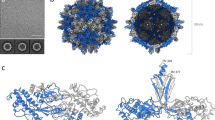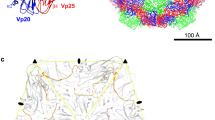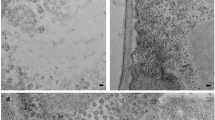Abstract
FURTHER work on preparations of proteins from virus-infected plants tends to confirm and extend the conclusions expressed in our previous letter1. We had there shown that both concentrated solutions of these proteins and the material prepared from them by drying gave orientated paracrystals. We have now succeeded in preparing the crystals of Stanley and Wyckoff in an orientated form, after trying unsuccessfully a number of methods, such as flow orientation. The method finally used was that of forcing mother liquor out of the crystals by centrifuging in an unglazed porcelain tube, in a saturated atmosphere. The resulting mush was orientated by rolling between glass slides, at 0° to avoid evaporation, becoming completely transparent in the process. It was mounted in a sealed brass case with bubble thin lindeman glass windows and examined by X-ray and optical methods without loss of water. It proved to be practically indistinguishable—in water content (50 per cent), optics and X-ray pattern at low and high angles—from the preparation previously called wet gel. On being allowed to dry, it likewise turns into a horny mass giving similar X-ray photographs to dry gel, though fainter and with slightly larger spacings, probably due to internal strain. The X-ray pattern obtained from the unorientated crystals shows all the main lines given by Wyckoff and Corey2 for their crystals, and we have been able to assign all but four very weak lines on these photographs to definite spots given by the orientated gel. There can therefore remain little doubt that their crystals are substantially identical with ours and with our previously described paracrystals.
This is a preview of subscription content, access via your institution
Access options
Subscribe to this journal
Receive 51 print issues and online access
$199.00 per year
only $3.90 per issue
Buy this article
- Purchase on Springer Link
- Instant access to full article PDF
Prices may be subject to local taxes which are calculated during checkout
Similar content being viewed by others
References
Bawden, F. C., Pirie, H. W., Bernal, J. D., and Fankuchen, I., NATURE, 138, 1051 (1936).
Wyckoff, Ralph W. G. and Corey, Robert B., J. Biol. Chem., 116, 51 (Nov. 1936).
Best, R. J., NATURE, 139, 628 (1937).
Bawden, F. C. and Pirie, N. W., NATURE, 139, 546 (March 27, 1937).
Author information
Authors and Affiliations
Rights and permissions
About this article
Cite this article
BERNAL, J., FANKUCHEN, I. Structure Types of Protein Crystals from Virus-infected Plants. Nature 139, 923–924 (1937). https://doi.org/10.1038/139923a0
Issue Date:
DOI: https://doi.org/10.1038/139923a0
This article is cited by
-
Evolution and ecology of plant viruses
Nature Reviews Microbiology (2019)
-
A history of plant virology
Archives of Virology (2006)
-
Virus crystallography comes of age
Nature (1980)
-
Neuere Beiträge zur Kenntnis der Taktosole
Kolloid-Zeitschrift (1960)
-
Reversible, Host-Induced, Changes in a Strain of Tobacco Mosaic Virus
Nature (1956)
Comments
By submitting a comment you agree to abide by our Terms and Community Guidelines. If you find something abusive or that does not comply with our terms or guidelines please flag it as inappropriate.



